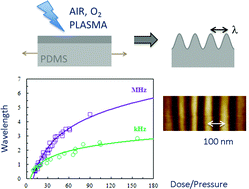Frontal vitrification of PDMS using air plasma and consequences for surface wrinkling†
Abstract
We study the surface oxidation of polydimethylsiloxane (PDMS) by air plasma exposure and its implications for the mechanically-induced surface wrinkling of the resulting glass–elastomer bilayers. The effect of plasma frequency (kHz and MHz), oxygen content (from O2 to air), pressure (0.5 ≤ P ≤ 1.5 mbar), as well as exposure time and power, is quantified in terms of the resulting glassy skin thickness h, inferred from wrinkling experiments. The glassy skin thickness is found to increase logarithmically with an exposure time t, for different induction powers p, and all data collapse in terms of a plasma dose, D ≡ p × t. The kinetics of film propagation are found to increase with the oxygen molar fraction yO2 and decrease with the gas pressure P, allowing both the wrinkling wavelength λ and amplitude A to be effectively controlled by gas pressure and composition. A generalised relationship for frontal vitrification is obtained by re-scaling all λ and h data by D/P. A coarse-grained wave propagation model effectively describes and quantifies the process stages (induction, skin formation and propagation) under all the conditions studied. Equipped with this knowledge, we further expand the capabilities of plasma oxidation for PDMS wrinkling, and a wavelength of λ ≈ 100 nm is readily attained with a modest strain εprestrain ≈ 20%.


 Please wait while we load your content...
Please wait while we load your content...